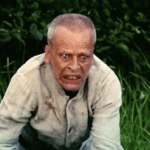 Weird Stuff
Weird Stuff  Weird Stuff
Weird Stuff  Our World
Our World 10 Ways Your Christmas Tree Is More Lit Than You Think
 Movies and TV
Movies and TV The 10 Coolest Stars to Set Sail on The Love Boat
 History
History 10 Things You Didn’t Know About the American National Anthem
 Technology
Technology Top 10 Everyday Tech Buzzwords That Hide a Darker Past
 Humans
Humans 10 Everyday Human Behaviors That Are Actually Survival Instincts
 Animals
Animals 10 Animals That Humiliated and Harmed Historical Leaders
 History
History 10 Most Influential Protests in Modern History
 Creepy
Creepy 10 More Representations of Death from Myth, Legend, and Folktale
 Technology
Technology 10 Scientific Breakthroughs of 2025 That’ll Change Everything
 Weird Stuff
Weird Stuff Ten Bizarre Facts About The Doge Meme
 Our World
Our World 10 Ways Your Christmas Tree Is More Lit Than You Think
 Movies and TV
Movies and TV The 10 Coolest Stars to Set Sail on The Love Boat
Who's Behind Listverse?

Jamie Frater
Head Editor
Jamie founded Listverse due to an insatiable desire to share fascinating, obscure, and bizarre facts. He has been a guest speaker on numerous national radio and television stations and is a five time published author.
More About Us History
History 10 Things You Didn’t Know About the American National Anthem
 Technology
Technology Top 10 Everyday Tech Buzzwords That Hide a Darker Past
 Humans
Humans 10 Everyday Human Behaviors That Are Actually Survival Instincts
 Animals
Animals 10 Animals That Humiliated and Harmed Historical Leaders
 History
History 10 Most Influential Protests in Modern History
 Creepy
Creepy 10 More Representations of Death from Myth, Legend, and Folktale
 Technology
Technology 10 Scientific Breakthroughs of 2025 That’ll Change Everything
10 Insane Non-Religious Cults
The word “cult” was originally synonymous with the word “sect,” which referred to a religious group that was critical of society and accepted voluntary membership. “Cult” eventually gained the modern definition of a religious group with unorthodox beliefs, charismatic leaders, and the use of psychological manipulation to gain and keep members. Many now see parallels between religious cults and some ostensibly non-religious groups. These groups may be therapeutic, economic, corporate, or political in character, but they share tendencies with religious cults, including unquestioning commitment to charismatic leaders, punishment of dissent, mind-altering practices and rituals, and deceptive recruitment tactics.
10 Tvind

In the 1970s, Denmark’s liberal education policy allowed state funding for any private school in the country. A group of anti-establishment teachers led by iconoclast Mogens Amdi Petersen formed the Tvind Teacher’s Group to take advantage of those policies with the intention of creating an education system that would help troubled youth while also leading to the abolition of inequality, racism, and nuclear power. Petersen was a Maoist who sought to create progressive “traveling folk high schools” where teachers and students traveled together to third world countries to help the poor. In reality, Tvind quickly became a cult under the absolute leadership of Petersen. It followed a number of draconian principles: common economy (where Tvind members invested their entire savings and earnings into a common account and supported themselves on pocket money given by the group), common time (where members agreed to forgo all free time and arrange their plans with Tvind management), and common distribution (in which the Tvind decided where a member would work). Tvind would not allow any member to set conditions or make claims to personal rights over their money, time, or work environment.
Since the 1970s, Tvind expanded widely, becoming a complex web of educational and charity organizations in Scandinavia, Africa, and around the world, with Petersen and his colleague Kirsten Larsen. The organization took on a variety of names to mask their origins, including Humana and Planet Aid. Many of these organizations were ostensibly charities, but most of the income was funneled directly back to the main Tvind organization. Young, idealistic students were tricked into joining the organization through slick advertising only to be swindled, exploited, and forced to cut off ties with friends and family. Tvind ideology stated that Amdi Petersen was infallible but persecuted by a corrupt society. In 2013, Petersen was sentenced to prison in Denmark for financial crimes, but the cult leader remains at large and is believed to be on the run in Mexico.
9 Yilishen Tianxi Group

Pyramid schemes and other forms of multilevel marketing are often considered secular cults due to their methods of operation, their aggressive recruitment, and magical thinking. Such schemes are rife around the world, particularly in China. One particularly egregious scheme, with a larger than usual mystical element, emerged in the form of an ant farming scheme by the Yilishen Tianxi Group in Liaoning Province. Investors, generally farmers, retirees, and the unemployed, were convinced to spend $1,375 on a box of ants. They would need to look after the ants and give them food and water for the next 72 days. Then a Yilishen representative would pick up any dead ants to be processed into powder used as an aphrodisiac, kidney purifier, and supposed cure for arthritis. The ants came with a cardboard box with a 5-centimeter (2 in) plastic window and feeding hole. An arcane list of feeding instructions was also included, involving 9:00 AM spritzing with water mixed with sugar or honey as well as cake and egg every 3–5 days.
Over a million investors fell for the seemingly ridiculous scheme; in China ants are believed to increase stamina and sexual potency, increase immunity, and prolong life. The company founder, Wang Fengyou, was a master at political connections and self-promotion, establishing himself as a philanthropist, appearing on state television, and receiving endorsements from celebrities and ant breeders. The economically vulnerable individuals who fell for the scheme were promised $447 in the first 14 months, and then an annual rate of return of up to 32.5 percent. The scheme ran for eight years before collapsing, leaving thousands of investors out of luck. Worse, close ties between Yilishen and the government have meant that the debacle has been suppressed in the media and attorneys warned against representing the victims. Thousands of ant farmers who descended on the company were even allegedly beaten and detained by riot police.
8 Re-Evaluation Counseling

Harvey Jackins was a young Maoist who got involved with L. Ron Hubbard in the early 1950s, during the early years of the “science of dianetics.” They eventually parted ways; Hubbard founded Scientology, and Jackins developed Re-Evaluation Counseling. It is described as a process of freeing human beings from distressing patterns in order to live a more fulfilling life. The idea is that human beings are essentially good, and that we act badly due to “restimulation” of past hurts that have not been “discharged” correctly. The process of re-evaluation counseling involves a counselor and a client collaborating to work through and interrupt the client’s patterns of distress. The end result is meant to increase intelligence, life enjoyment, sociability in both individuals, and eventually society overall. Jackins told the House Un-American Activities Committee in 1954 that: “We have discovered, a human—any limitation on his life, his enjoyment of life, his ability to be intelligent in any situation—is purely the result of the experiences of hurt which he has endured, including emotional distress.” Much of this distress is believed to come from childhood abuse, with Jackins claiming that almost all women and most men suffered sexual abuse at a young age. Much of the counseling involves the counselor trying to link contemporary issues or dissatisfaction with childhood memories, which causes emotional outbursts and even the generation of false memories.
The center of the movement is in Seattle, Washington, where the headquarters of The International Re-evaluation Counseling Communities is located. It is under the leadership of Tim Jackins, who is the President of the organization as well as the “International Reference Person” with absolute power over leaders in the organization. The organization runs classes in its therapy approaches, with a varying rate to study depending on income. Scholarships are also available. The organization believes that mental illness does not exist and has no links with any psychiatric or psychotherapy group. They are extremely isolationist, defensive of any external criticism, and under a strictly authoritarian rule. The organization dismisses attacks on it as “dramatizations of distress,” and those within the group who persist in criticizing it are expelled.
7 Workers’ Institute Of Marxism-Leninism-Mao Zedong Thought

In 1970s Great Britain, political radicals dissatisfied with the Soviet-aligned Communist Party of Great Britain (CPGB), as well as alternative Trotskyist groups formed splinter movements inspired by Maoism and the Cultural Revolution. Isolated and confrontational, these groups found it very difficult to expand and became obsessed with specific dogmas and literature. Aravindan Balakrishnan (a former member of the Communist Party of England [Marxist-Leninist] which was already a radical Maoist group criticized by other leftists for thuggery) was expelled for factionalism and formed his own following: the Workers’ Institute of Marxism-Leninism-Mao Tsetung (later Zedong) Thought. The movement maintained a rock-solid commitment to Maoism even as other movements and China itself moved away from the philosophy. Balakrishnan’s group only became ever more isolated and extreme as time went on, limited to distributing pamphlets of their idiosyncratic and baroque political beliefs and disrupting meetings of other leftist groups. Calling himself “Comrade Bala,” the leader compared himself to Jesus Christ and dominated the military-style organization of the group. Members were cut off from their families and encouraged to donate all their money to “the revolutionary cause.”
After Mao’s death in 1976, the movement established the Mao Tsetung Memorial Center in Brixton, a district in London. Claiming to be an actual section of the Chinese Communist party, the Center ran films and lectures and also operated as a collective composed of former international students, mostly women. The Center was raided by the police in 1978, and afterwards the movement proclaimed a “new long march” and went underground. The collective went off the grid, but a few women remained with the group as it migrated between London houses over 30 years under the complete control of Bala and his wife Chanda. When police raided the group’s hideout in 2013, they discovered three women had been held as virtual slaves for years by Balakrishnan and Chanda, who were then arrested. One of the women, who had a birth certificate but no other documents, was believed to have been in servitude almost her entire life.
6 Straight, Inc.
In 1974, a US government report into the drug rehabilitation program Seed, Inc. compared its behavior modification techniques with North Korean brainwashing used in the 1950s. The resulting controversy and demands for clients to sign consent forms agreeing to human experimentation led to the closure of the company. Mel Sembler, the former Ambassador to Italy whose son had been in the Seed program, formed Straight, Inc. from members of Seed and used many of the same techniques. The organization claimed to use tough love and Alcoholics Anonymous techniques to help teenagers overcome drug addiction. In reality, this meant that former program graduates were put in charge of treatment, referred to as “positive peer pressure.” This amounted to a heinous regime of brainwashing, public humiliation and confrontations, food and sleep deprivation, kidnapping, isolation, and abuse. This led to program graduates suffering from depression and post-traumatic stress disorder, with some committing suicide. The psychological manipulation, isolation, and heavy ritualism of the Straight program made it classifiable as a mind control cult.
According to one survivor, those in the program were forced to write “moral inventories” detailing how sex and drugs had destroyed their lives, participate in “motivational-confessional” sessions where they were compelled to reveal their deepest secrets, and do military-style exercises. The teenagers, called “Straightlings,” were held in captivity at the foster homes of parents of other inmates under the watchful eye of program graduates. Physical, psychological, and sexual abuse was rife, all in the name of rehabilitation. Eventually, enough controversy and public outrage over the abuses led to Straight’s closure in 1993, but it was quickly revived under a different name as SAFE. After several incarnations, the contemporary version is the Drug Free America Foundation, which is still run by the Semblers and desperately fighting against marijuana legalization.
5 Center For Feeling Therapy

In 1971, two rogue therapists, Richard J. (Riggs) Corriere and Joseph T. Hart Jr., founded the Center for Feeling Therapy. They had split from the Primal Therapy movement, which was focused on separating thought and behavior in order to emphasize feelings. It had the rather unfortunate side effect of turning people into non-functional basket cases without any way of censoring their emotions. Corriere and Hart set out to develop a form of Primal Therapy that had all the benefits of the treatment but would allow patients to remain functional members of society. They believed that most individuals go through life “reasonably insane” but that if an individual gave 100 percent in five areas—expression, feeling, activity, clarity, and contact—he would become “sane,” defined as “full experiencing of feelings” and the next step in human evolution.
The group treated 350 patients living in the Hollywood area of Los Angeles, and hundreds more “outpatients.” Those who were residents were seen as the most likely to have real progress. In reality, the so-called therapy used social isolation, enforced dependency, mental and physical exhaustion, and incessant verbal abuse to keep patients unbalanced and therefore “too crazy to leave.” Expressing feelings was all that mattered, with one former neighbor of Center patients reporting endless screaming: “I hate you, I f—n’ hate you!,” “I feel bad, I f—n’ feel bad!” and sometimes “I feel good, I f—n’ feel good!” This group used mind control and gas-lighting to induce shame and humiliation, ostensibly to help patients reach their feelings but working instead to allow the therapists to completely dominate the patients, which led to physical and sexual abuse within the group. One man was ordered by his therapist to live like a baby for a week, complete with baby food, diapers, and a crib. An overweight woman was forced to take off her blouse, get on all fours, and moo like a cow. Many others reported being stripped, beaten, pressured to cut off contact with their parents, pressured to get abortions, raped, and coerced into sexual relations with other patients. The Center closed in 1980, and in 1987 Corriere and Hart were charged with gross negligence, incompetence, patient abuse, aiding and abetting the unlicensed practice of psychology, false advertising, professional misrepresentation, and fraud.
4 Aesthetic Realism

Eli Siegel, an artist and poet living in Greenwich Village in New York in the 1940s, taught a philosophy of what made successful art and how art can impact people’s lives. The ideas he developed became Aesthetic Philosophy, the idea that each individual is driven by a desire to truly like the world honestly while also desiring to feel contempt for the world. Aesthetic Philosophy taught that it was the way one sees the world that causes mental mishap, and that it is an ethical imperative to do one’s best to see the world as it really is. Being critical is a victory for contempt, which poisons the mind and creates unhappiness. The philosophy also emphasizes the beauty of opposites, reflecting Siegel’s artistic side. The ideas seemed benign and humanistic, but they held a dark side.
Siegel believed that he had discovered the one true route to happiness, and his followers soon formed into a cult around his ideas. Recruitment into the cult usually involved an invitation to a art exhibition or drama presentation at Soho’s Terrain Gallery, a front for the cult, after which the individual would be pressured into Aesthetic Realism classes and later into “consultation” sessions to help improve their life. The consultations were actually a kind of therapy intended to break down an individual’s self-identity and push them into accepting Aesthetic Realist teachings. The key technique used was “directed origination,” asking leading questions to trick a potential recruit into making a statement that conformed to the group’s beliefs, psychologically committing the potential recruit to the position. In 1977, Siegel died of prostate cancer, and a new leadership composed of his most trusted disciples rose in his place. The cult still exists, running lectures and workshops on Eli Siegel’s teachings, giving reenactment performances of his consultations, and attempting to “cure” homosexuality.
3 LaRouche Movement

Lyndon LaRouche began his road to cult leadership as a Marxist living in Greenwich Village in the 1970s, where he founded the National Caucus of Labour Committees. He became known for his dogmatism and brilliant theoretical insights, and his followers were said to have physically attacked members of other leftist groups. In 1973, LaRouche intiated “Operation Mop-Up,” an outright war on the Communist Party of the USA involving metal pipes, clubs, and nunchaku. During this period he developed a set of techniques called “Beyond Psychoanalysis,” during which LaRouche and his trusted allies would ruthlessly grill followers on their weaknesses, sexual feelings, and personal lives, breaking them down psychologically and creating pseudoreligious mania. The purpose of all this was political, with LaRouche saying in a memo, “I AM GOING TO MAKE YOU ORGANIZERS—by taking your bedrooms away from you . . . What I shall do is expose to you the cruel act of your sexual impotence . . . I will take away from you all hope that you can flee the terrors of politics to the safety of ‘personal life.’ ” Fears that the government was brainwashing members led to the LaRouche organization pursuing “deprogramming” using drugs and electric shock treatment; one of the subjects of the process was a British follower who had married LaRouche’s ex-wife.
LaRouche became wealthy developing computer software for the haulage industry, and he used this money to expand his political organization in the 1970s and 1980s. The movement took a swing from the left to the right, turning against liberals and environmentalists and supporting the Reagan administration. He was imprisoned in 1989 for mail fraud and illegal fundraising but released in 1994. After his release, his movement changed focus to its LaRouche Youth Movement, a group of young followers that hang around university campuses luring in potential recruits with pamphlets. If anyone shows interest in attending a meeting, psychological and emotional manipulation are used to bend them to the organization.
Today, the LaRouche movement remains a committed core of followers of an extremely idiosyncratic political philosophy that is highly conspiratorial and neither left- nor right-wing. The movement believes that a cabal of corporations and European aristocrats led by Prince Philip is behind the international drug trade and seeks to reduce the Earth’s population to one billion through the deindustrialization of the third world. He and his followers believe that the Queen of England is the ultimate threat to humanity, looming over a conspiracy web of Zionists, Jesuits, Freemasons, Rockfellers, environmentalists, fundamentalist Muslims, orthodox Christians, feminists, homosexuals, Satanic rock-and-rollers, and the International Monetary Fund.
2 Amway Motivational Organizations

The largest multilevel marketing scheme in the world, Amway works on the premise that you are your own boss and buy Amway products like soap, water purifiers, vitamins, and cosmetics to sell for a profit. To really make money with the system, however, involves signing up more people into Amway, which gives you a share of any profit they make. This sounds like a pyramid scheme, which it essentially is, but the company does not charge anything for joining or recruiting. What does this have to do with cults? Amway has also been accused of being a corporate cult, a business that encourages employee loyalty and enthusiasm through the same tactics used by religious cults. This aspect of Amway cultism occurs through its “Amway Motivational Organizations (AMOs),” rather than the corporation itself.
AMOs are a collective group of Amway product distributors, or “upline distributors” which seek to recruit new people into the fold. Their tactics of recruitment involve deception, psychological manipulation, and mind control. “Downline” distributors are pressured into participating in the “system of success,” meaning purchasing motivational materials like videos and attending massive pep rallies and meetings. As the upline distributors do not need to share the profit of sales of motivational products, they have an incentive to build a “downline” sales network, using psychological manipulation to create devotion to the brand. There is immense pressure to be “successful,” which means buying into Amway products 100 percent and cutting off contact with friends and family who don’t support one’s work in “the business.”
Top distributors become “Diamonds,” those at the top of the pyramid who gain the most profit from the sales network below. At AMO meetings, Diamonds in smart suits and shiny dresses will speak of the hardships they suffered to achieve success while videos of their houses, cars, and yachts play behind them. This is designed to indoctrinate members into the Amway system of success and to buy into the narrative without stopping to check the figures. AMOs offer a vision of financial success painted in terms closely resembling religious salvation, and this is deeply linked with the motivational materials: “The tools are optional, but so is success.”
1 Walmart
The idea that Walmart is a cult is, at face value, a bit ridiculous, until you look closer. According to Michael Bergdahl, former “Director of People” for Walmart’s Headquarters, the aim of Walmart recruitment is cult-like commitment and devotion to the “Walmart Way” and the “Walmart Family.” This devotion is obvious in the Walmart Careers Testimonials page (removed in 2013) which includes such sycophantic praise as, “Walmart is my Life. When I think about it, it’s amazing how many aspects of my life are touched and made better by Walmart.” The lessons learned in the recruitment process are reinforced daily with a required devotional chant, the Walmart cheer.
“Give me a W!
Give me an A!
Give me an L!
Give me a Squiggly!
Give me an M!
Give me an A!
Give me an R!
Give me a T!
What’s that spell?
Wal-Mart!
Who’s number one?
The Customer! Always!”
The culture of Walmart was formed in the Bible Belt in the 1950s with a corresponding set of values: frugality, self-development, obedience, and hard work. There is a personality cult around founder Sam Walton, who is always referred to as “Mr. Sam.” Despite his death in 1992, he is ever-present for Walmart employees (or “associates”), who are taught “what would Sam do?” and bombarded with rules and anecdotes attributed to the company founder. High-level associates once gathered for 7:30 AM Saturday motivational pep rallies that involved prayer, company songs, and public humiliation and praise as each manager gave their weekly sales figures. Managers acted out a ritual of confession as the public gave step-by-step accounts of what went wrong and how to fix it.
The cultish side of Walmart extends beyond the stores themselves. Curtis DeBerg, professor at California State University, Chico, wrote a book about the cultish nature of a campus group linked to Walmart: Students in Free Enterprise (SIFE), now known as Enactus. The group, calling itself “the world’s best-known and most successful program helping university students to create community empowerment projects,” is in reality a means of indoctrinating bright students into the Walmart ideology and funneling them into management positions. The ideology, according to DeBerg, is “servant leadership,” in which a manager works to empower his employees while serving his company as one of them, even if it means shaving your head or dancing the hula in the street like Sam Watson did. The problem is that the ideology is a farce, created to keep the managers in line, on point, and vaguely terrified, while the real business leaders reap the profits.
David Tormsen hopes the secret to success doesn’t involve eating dried ants.








